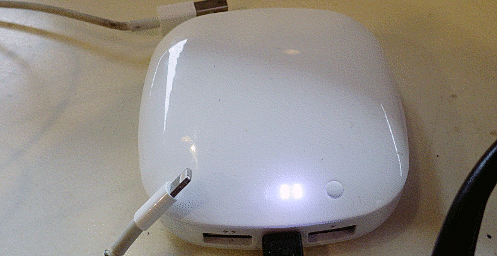Homeless in Vancouver: Dumpster diver finds semi-precious stone
Yesterday a Dumpster diver wanted me to appraise something he had dug out of someone’s garbage.
The glossy white thing was adorned with the words “Lepow Stone Power” and punctuated by three USB ports (one with a cable still attached) so it was obviously tech of some kind. Otherwise it was the right size and shape to be a very serviceable skipping stone.
The Moonstone the resident rejected

Very often it looks as though Fairview renters, with their over-priced and under-sized apartments, are using Dumpsters as the storage solution of last resort. Certainly some of the stuff they throw away is classic garbage: worn-out, broken, or just plain old. But very often it isn’t.
The thing the Dumpster diver showed me appeared to be neither broken nor obsolete. Rather it was something quite useful—a Lepow Moonstone 3000 portable power bank—a way to charge a dead mobile device when you’re nowhere near a plugin.
When the fellow dug it out of the Dumpster it still had an Apple lightning connector attached to it—one of the two connector cables the Moonstone ships with—that’s handy to have by itself.
Lepow, a Hong Kong-based company, still sells the Moonstone 3000 on its web site.
Until I use it to charge something, I won’t know if it really still works but I was certainly able to charge the Moonstone via a USB port on my laptop.
It was already 50 percent charged and took about four hours to completely fill up.
Simple like a rock but much lighter
The Moonstone is a small, lightweight device the size of makeup compact—a tad over three inches square—and dead simple to use.
On the bottom is a LED battery charge indicator similar to what’s on the bottom of many Apple laptops. On the back is a micro USB port for charging the Moonstone flanked by two full-size USB ports for charging mobile devices: one port charges at 500mA and the other port quick-charges at 1200mA. You can use both ports at the same time to charge two devices.
The Moonstone 3000 is basically a lithium polymer battery with intelligent charging circuitry and a maximum capacity of 3000mAh. It’s meant to charge small digital devices such as phones, tablets, mp3 players, cameras and handheld gaming consoles like the PSP.
Lepow says the battery will hold a full charge for up to six months.
Buyer reviews say that once the battery is fully charged it will, in turn, fully charge a mobile phone in a little over an hour and it will do it more than once—maybe three times.
Take away electricity and smartphones are less useful than Sumerian mud bricks.
I’ve seen a few people using portable power sources to revitalize their dead phones. They all looked quite glum; sitting quietly on park benches, watching their recharging smartphones for signs of life.
I have never waited long enough to see but I have no doubt their faces lit up as their screens did.
I can’t find it advertised in Vancouver stores but Lepow sells the Moonstone 3000 on its website for only US$24.99. The larger capacity Moonstone 6000 is available from other online sellers for as little as US$17.99.
I did say it was only semi-precious.
Sticks and stones and all that
The computer industry just loves naming complicated doo-dads after uncomplicated natural things, like sticks. This evokes a simpler time, just after we came down out of the trees, when technology was still easy to use. When you didn’t need to take courses or read manuals. You could just pick it up—literally—off the ground and it worked.
We’ve had USB sticks since the 1990s, Pebbles are a brand of smartwatch and Lepow’s various Stones were preceded back in 2007 by the Creative Zen Stone MP3 players.
So far no tech product that I know of has been named after nuts, but RIM has its BlackBerry and in 2011 a company called XO Vision brought out a 4.3-inch Android tablet called a Twig. As well, two years ago, there was a successful Kickstarter campaign to crowdfund a Twig iPhone cable.
And when it comes to trying to make the most complicated technology sound perfectly natural, nothing beats the Cloud.















Comments
1 Comments
woods
Dec 9, 2014 at 11:38am
In a <a href="http://en.wikipedia.org/wiki/Dumpster">dumpster</a>... really?